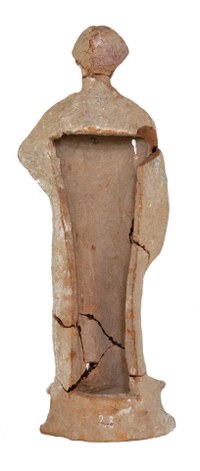Aphrodite
|
Aphrodite, Inv. T I-33 Front from the mould; back smooth, not finished. Very large highly rectangular kilning hole. Grey-brown (7.5YR 6/3) clay. Abundant white engobe, traces of blue paint at the hem and at the folded-over tip of the chiton. Provenance: Athens Art Trade. Acquired by Bruno Sauer with special funds for the university anniversary in 1907. State of preservation: Assembled from several fragments, head glued on. Head of hair on the calotte lost. On the back, triangular fragment broken out of the upper right corner next to the kilning hole. Injuries on the right shoulder and on the right side of the neck; small defect on the robe on the left shoulder. Restored and conserved: L. Hünnekens (ed.), Workshop Panorama (2006) p. 36. Dimensions: H: 26,2 cm; W: 9,4 cm; D: 6,5 cm. References: D. Graen – M. Recke, Herakles & Co (Gießen 2010) 71-72 fig. 33; E. Neuffer, Griechische Terrakotten, Heimat im Bild. Beilage zum Gießener Anzeiger 17, 1930, 67 fig. 3; M. Recke – O. Schneider, Erhaltenswert. Akamas 3 (Gießen 2009) 23 fig. 14. |
Description: On a round profiled plinth stands a female figure whose garments have slid down from the right shoulder, exposing the upper part of the body with both breasts up to the edge of the ribs. Of the thin chiton, only fine folds are visible at the hem folded over at the top, between the feet and on the back of the right foot. Above this is a fabric-rich cloak which wraps the supported left arm and falls in steep folds down to the ground. The lower hem of the cloak runs diagonally upwards from the right foot over the left ankle. The hip rounds over the supporting left leg. The right leg is placed slightly further forward with the knee slightly bent. The right arm hangs down, the hand reaches into the fabric and pulls the coat slightly to the side. The left arm is bent, the hand resting on the waist with the back of the hand.
The slightly lowered head turns barely noticeably to the right. Long strands of hair looped around a hoop frame the high forehead; they are gathered into a bundle at the top of the calotte.
The oval face tapers from the eye area over the smooth cheeks to the round chin. Small relatively wide-set eyes with upper lids indicated in a band lie under high orbitals. The full lips form a small closed mouth, the width of which does not quite reach that of the nostrils.
Commentary: A photograph taken around 1930 shows the figure with a steeply rising mop of hair consisting of two thick, tightly joined, twisted bundles of hair [1]. Originally there were also long wavy strands on the shoulders - according to the parallels - but even then they could only be recognised by the impressions and erosions on the neck and shoulders.
The almost completely exposed upper body and the protruding left hip, whose pleasing curve is underlined by the gracefully supported hand, leave no doubt about the interpretation of this figure as Aphrodite. The position of the differently supported legs and the swing of the hips connect her to the statue type Aphrodite "Louvre-Naples" [2]. However, the different drapery of the garment, which leaves both breasts uncovered, and the different gestures distinguish her from the latter. The left arm supported on the hip is a characteristic of the portrait statue of Sophocles, which was erected in the newly designed Athenian Dionysus Theatre around 325 BC and is preserved in the well-known slightly larger-than-life Roman marble copy from the Lateran [3].That arm motif soon appears in coroplastic art, where it is reproduced and modified [4]. A statuette from the Loeb Collection in Munich could be considered the predecessor of the Giessen Aphrodite [5]. This is supported by the similarities in the stace motif, the movement of the left arm and the inclination of the head; however, the two copies differ in the draping of the mantle and the posture of the right arm. Closely comparable examples of larger format are missing. The connection with Athena Velletri [6] proposed by U. Mandel is less convincing than the correspondence with Asclepius statues of the Giustini type [7] also seen by her.
The terracotta figure from Giessen is designed as a round sculpture. On the left side, the view is stopped by the angled outward arm and the steep folds of the cloak. Thus the prototype of this statuette may have been created at the end of the classical period, on the threshold of Hellenism. The light tone colour points to Boeotia, where most of the parallels were made.
Determination: Last quarter of the 4th century BC. Probably from Boeotia.
 |
 |
 |
[1] Neuffer ibid. 67, fig. 3.
[2] P. Karanastassis, Untersuchungen zur kaiserzeitlichen Plastik in Griechenland. I. Kopien, Varianten und Umbildungen nach Aphrodite-Typen des 5. Jhs. v. Chr., AM 101, 1986, 207-291 pls. 46-50. 52. 55-62. 65; P. C. Bol – E. Kotera, Liebighaus Frankfurt am Main, Bildwerke aus Terrakotta (Melsungen 1986) 104-106 fig. 54.
[3] R. Krumeich, Die lykurgische Tragikerweihung< in: Die griechische Klassik. Idee oder Wirklichkeit (Berlin 2002) 542-544 cat.-no. 408.
[4] Aphrodite-Statuetten: U. Mandel, Kleinkunst der späten Klassik: Koroplastik, in: P. C. Bol, Die Hohe Klassik: Nichtphidiasische Attische Bildwerke, in: id. (ed.), Die Geschichte der antiken Bildhauerkunst II Klassische Plastik (Mainz 2004) 450 figs. 412. 414; Stemmer ibid. 87-89 fig. E 10. 87 ff. fig. 5. 18. 29. Mandel ibid. 460 figs. 438. 439.
[5] Mandel ibid. 448 fig. 412; J. Sieveking, Die Terrakotten der Sammlung Loeb (München 1916) 24 pl. 33.
[6] Mandel ibid. 434 f. fig. 138.
[7] id. ibid. 435 figs. 265. 266 (Geominy 2004 ibid. 297); E. Berger, Zwei neue Skulpturenfragmente im Basler Ludwig-Museum: Zum Problem des >Asklepios Giustini< in: Festschr. Ulrich Hausmann (Tübingen 1982) 63-71 pls. 9, 2-4. pl. 11,1.

